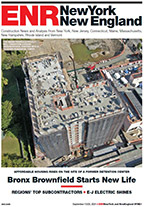The public works project types as a whole advanced 26% in September. The miscellaneous public works category increased 83%, which reflected the start of the $834-million Regional Connector Transit Corridor light rail project in Los Angeles, a $204-million liquefied natural gas pipeline project in Tucson, Ariz., and a $150-million gas main replacement project in Hackensack, N.J.
The miscellaneous public works category in September also included groundbreaking for the $672-million Atlanta Braves baseball stadium in Smyrna, Ga. (In the Dodge classification of sports arenas and stadiums, projects with a roof are included in the amusement category while projects without a roof are included in the miscellaneous public works category.)
River-harbor development in September climbed 40%, lifted by a $117-million storm sewer project in New Orleans, while sewer construction rose 31%, with the boost coming from a $285-million wastewater treatment plant in Baltimore.
Highways and bridges each climbed 8% in September, although both are still trending downward as shown by the following year-to-dates declines—highways, down 11%; and bridges, down 21%. Water supply construction was the one public works category to lose momentum in September, sliding 27%.
Residential Building
Residential building in September dropped 9% to $212.7 billion (annual rate). Multifamily housing fell 23%, retreating from the strong activity that was reported in August. Even with this decline, September still included groundbreaking for four multifamily projects valued each in excess of $100 million. They were the following: a $266-million condominium hotel in Hollywood, Calif., the $230-million multifamily portion of a $370-million mixed-use project in Washington, D.C., a $215-million condominium complex in Honolulu and a $183-million condominium tower in Miami.
Through the first nine months of 2014, the top five metropolitan areas in terms of the dollar amount of new multifamily projects were: New York City, Washington, D.C., Miami, Los Angeles and San Francisco. Metropolitan areas ranked six through 10 were: Dallas-Ft. Worth, Boston, Houston, Seattle and Denver.
Single-family housing in September slipped 3%, marking the third straight month of modest erosion after a brief pickup in late spring, which in a broad sense maintains the flat pattern that’s been present throughout 2014. In September, weaker single-family construction was reported in the South Atlantic, down 6%; the South Central, down 4%; and the West, down 3%; while gains were reported in the Midwest and Northeast, up 2% and 4% respectively.
Murray said, “This year’s stall for single-family housing means that the lift provided to total construction is much less than what occurred during the prior two years, when single-family housing advanced 29% in 2012 and 26% in 2013. The 20% down-payment requirement, generally in effect since the end of the financial crisis, has made it difficult for lower and middle income households to get approved for a mortgage, and more attention is now being directed by federal officials at ways to expand access to home loans.”
The 5% gain for total construction starts on an unadjusted basis during the first nine months of 2014 was the result of a varied pattern by major construction sector. Nonresidential building climbed 17% year-to-date, due to this performance by segment— commercial building, up 13%; manufacturing building, up 112%; and institutional building, up 5%. Residential building grew 6% year-to-date, with single-family housing up only 1% while multifamily housing advanced 20%.
Nonbuilding construction decreased 9% year-to-date, with public works down 8% and electric utilities down 13%. By geography, total construction starts in the first nine months of 2014 revealed these gains for the five major regions—the South Central, up 15%; the South Atlantic, up 5%; the Northeast, up 4%; and the Midwest and West, each up 1%.



